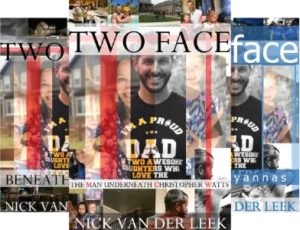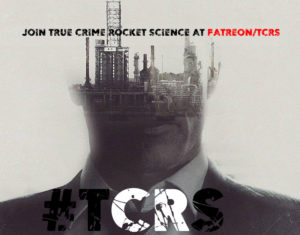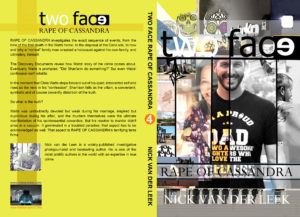True crime asks simple questions. When? Where? How? Why? Sometimes we don’t get satisfactory answers to one of these questions. When [time of death] – for example – can be particularly troublesome.
In a few cases we may have uncertainty around not one, not two but all of these questions. This is particularly true when the body is never recovered, or [as in the Watts case] chemically destroyed beyond the ken of powerful technologies that would usually shed some light.
Just as in the Chris Watts case, troubling uncertainty persists about where the crime was executed in the McCann case. While many of the hordes have moved on with Chris Watts’ “Second Confession” narrative, they seem to have forgotten the alerts the cadaver dogs made inside the house, including in the basement. These are now simply dismissed as dogs barking for no reason at all. Of course, the same scenario presents itself in the McCann case. Dogs alert, but inconclusive DNA results then “proves” the dogs weren’t necessarily right. But what if they were?
In the McCann case if we are to persist in asking about where Madeleine died [assuming she died on May 3rd at the apartment], there’s clearly no obvious answer. Amaral seems to think the forensic evidence points towards the child falling on the tiled floor beside the couch, and suffering a significant wound leading to arterial spray.
To my mind a significant wound causing significant arterial spray and a fall from less than one vertical metre aren’t compatible. That’s not to say not possible, simply unlikely in my view.
A more plausible scenario for a serious, life-threatening injury is a fall from at least twice that height or even more, and onto an irregular surface.
While researching the DOUBT trilogy, I started investigating an area of the apartment that – to the best of my knowledge – no one else has looked at in any detail. It’s the balcony area outside the main bedroom.
As I persisted in my research I grew increasingly frustrated with this line of inquiry. I couldn’t find any information! I discovered to my chagrin, if there are two areas that are least documented in the Madeleine McCann case they are 1) the balcony outside the main bedroom and 2) the area directly under the balcony.
Typically the view one sees in the media of apartment 5A is this sort of image:

In effect you can see almost none of apartment 5A other than the two windows on the east elevation, and the entrance to the patio doors. It’s a patently useless image yet it’s the default image used to depict the scenario rather than the actual crime scene.
Here’s another example of a view of nothing.

And another.

And another.

And another.

Interestingly, in my attempt to see the balcony from the outside, I was by default proving how nonsensical the statement was that the parents could easily see their apartment from the Tapas Bar [and thus have a reasonable idea that their children were safe]. In point of fact, even from a few metres away, it’s impossible to see the patio doors, let alone a small child moving on the balcony.
I suppose one can argue semantics and say technically a portion of the apartment is visible from a distance, and so if that’s the case the apartment is visible. But when the parents say the apartment is visible the suggestion is clearly that it’s sufficiently visible for there to be adequate supervision from a distance.
But is this suggestion reasonable?
The image below is from the official police photos. Notice the width of the vertical slats in the balcony railing, as well as its relatively low height.

Clearly from this image taken from apartment 5H, which is one floor above the McCanns’ apartment and to the west, a small child moving on the patio wouldn’t be visible from their position lower down.
The McCanns’ apartment was on the ground floor, and vegetation on the perimeter walls block line of sight. Another reason is that the railing itself at 5A is “curtained” off by vegetation.
In Kate’s book she admits vegetation was a factor, but claims the apartment was “largely visible” from the restaurant.

Okay, but which part of the apartment was visible?
If one wishes to “see” onto the balcony of apartment 5A through direct line-of-sight, one has to achieve substantial elevation. As soon as one does one notices other idiosyncrasies of the ground floor apartments. They’re the only ones with vegetation growing along the railings. They’re also the only apartments with small garden spaces below, a concession perhaps intended to make up for the lack of a sea view.

Zooming in…








 And increasing the angle of elevation…
And increasing the angle of elevation…

Next I wanted to get a view of the garden alcove beneath the balcony at 5A. If images of the balcony were tough to find, the garden area was well-nigh impossible. And cursory research suggested it was unnecessary; the cadaver dogs had alerted in the flower bed on the other side of the apartment, hadn’t they?

Actually no, the above article is a misrepresentation. According to the PJ Files:
…on 31 July 2007 a search had been performed inside the apartment using English police dogs, one specialised in the detection of traces of human blood and the other in the detection of human cadaver scent.
They informed further that in that search the animal specialised in detection of human blood indicated the possible presence thereof on one of the floor tiles in the living room and that the dog specialised in detection of human cadaver odour had detected the presence thereof in the couple’s bedroom and in the back garden of the apartment.
[They proceeded] with the recovery of the floor tiles indicated by the dog specialised in the detection of human blood, with the recovery of hair in the corridor [pathway] that exists in the area of the back garden next to the window of the couple’s bedroom, with the recovery of several pieces of the branches of the climbing plant in the garden (for later check of possible blood traces on them) and with the recovery of possible fibres on the garden wall next to the climbing plant…
In the end the police reports provided the first, best images of this obscure garden area I was able to find. Ironically the images are provided under the following headline:
OFFICIAL INQUIRY FILES and DOCUMENTS 5A SAMPLES INDICATED BY EDDIE & KEELA REPORT
And so, here they are:


The sharpness and sheerness of that white paving strip on the ground can be appreciated better from this unusual view of the garden. Notice even from directly in front, and somewhat elevated, the balcony railing on the left side is still obscured by vegetation.

The above view provided in reverse, looking from the balcony above 5A in the direction of the Tapas Restaurant.

I mentioned at the outset that an irregular surface was more likely to cause a life-threatening injury from a fall [specifically one leading to a lot of arterial blood spurting].
Here it is:

But this is another possibility:

Cadaver alerts, however, were not on or below this staircase.
What’s interesting about the image above and those in the police file is how the vegetation has sprung up over the balcony by July 31st [three months after the incident]. Clearly the vegetation and balcony didn’t look like this on May 3rd. It looked like this:



But the most important image is this one.

The Balcony Narrative opens up a bunch of questions, scenarios and possibilities, doesn’t it? While researching DOUBT, it occurred to me we have the whole thing the wrong way round.
We are trying to see from the outside, and trying to examine line-of-sight from various angles. We’re looking at the apartment from the perspective of the McCanns, aren’t we? Obviously this line of questioning seeks to implicate or undermine the McCanns, and seeks to call into question whether or not they could or couldn’t see their apartment from the restaurant.

But this misses the point.
In a scenario where Madeleine may have fallen over the balcony railing onto the garden and paving section below, irrespective of whose fault it was or what caused it, we have to ask what she was doing there [if that’s where she fell] in the first place.
Put simply: where was she? If she was “there”, why was she there?
Detective Amaral provides some handy insight into this question by way of his explanation of a fall inside the apartment.

Amaral suggests Madeleine heard her father in the street, mounted the sofa and attempted to climb onto the wall and perhaps open the window, and that’s when she fell.
That’s a good theory, but – in my view – he’s on the wrong track. I won’t go into the reasons why his theory is unworkable other than to point out a fall at 21:00 would not provide sufficient opportunity for the formation of cadaver odor. There are other issues as well, but let’s leave those for the time being.
Yet if we take Amaral’s psychology of Madeleine hearing and then trying to see her father [or anyone for that matter] and we move this psychology to the balcony, we suddenly have a scenario. Instead of climbing onto a couch she climbs onto a railing. Instead of trying to reach a window [to see something] Madeleine’s trying to see over the railing, and climbs onto it to achieve that.
Even from this position clambering onto the railing it’s frustrating for the little girl, maddening in fact, trying to see towards the Tapas Bar and tennis court area which is – after all – right there. It’s so close!
To fully intuit this scenario we must transpose our frustration trying to see into and onto the balcony from the outside, with Madeleine standing on the balcony possibly trying to see out, and becoming increasingly agitated and persistent in her attempt.

In this scenario it’s not night time, and her parents aren’t necessarily dining at the Tapas Restaurant. One of her parents or someone she wishes to see [perhaps even another child] is in the play area below or at the tennis courts and Madeleine simply wants to see.
For whatever reason, Madeleine clambers onto the railing or through, or over it, just as she may have done in the jungle gym area beside the pool.
But the messy Bougainvillea interferes with her attempt, perhaps causing her to misjudge her effort. Perhaps once she’s in a critical position, stretching to see over a part of it the creeper she injures herself on a barb causing her to let go and loose her balance.
In the earliest footage of that fateful holiday, we see Madeleine eagerly clambering up the stairs into the aircraft and falling. So the little girl isn’t too timid to find her way onto and over things, even something as exotic as stairs leading onto a noisy airplane.

In some photos of the balcony taken from the side, the railing is no longer there.

This may be because it was defective, or rusted and needed to be replaced, or because it was removed [after the fact] in order to be forensically tested.
One way to explain why a £12 million investigation into Madeleine McCann was never successful is because the critical balcony aspect has been left out either through negligence or investigators not seeing the wood for the trees, so to speak.
The garden area and the balcony doesn’t appear in Kate McCann’s version of the crime scene, it’s incorrectly reported in the media [if it’s reported at all] and the even the diagram used by the Portuguese police doesn’t consider it part of the crime scene. Amaral himself also seems to exclude this area because he is focused on the possible arterial blood evidence behind and beside the blue sofa.















Recent Comments